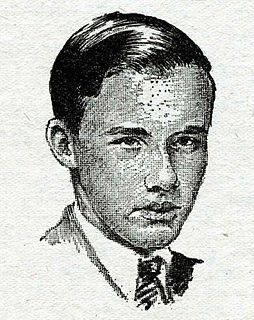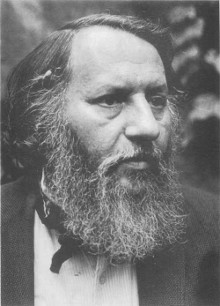Plot summary
Soldier of fortune Ali Moyang, leader of a band of Terran treasure hunters in the jungles of the planet Kterem, rescues archaeologist Charles Bertin, whose helicopter had crashed during an aerial survey. Moyang learns Bertin has located the site of the ancient ruins of Zhovacim, the very place he himself had been seeking to loot it of its historical tablets, made of gold. Moreover, the archaeologist has established good relations with the notoriously touchy Kteremian natives. To Moyang, Bertin represents an unprecedented stroke of luck.
Bertin, distressed at the thought of the tablets' loss to science, attempts to talk Moyang out of his raid. Failing, he agrees under duress to serve as intermediary between the treasure hunters and the native Kteremians of the village closest to Zhovacim. But he has an ace up his sleeve in his knowledge of Kteremian culture and psychology.
The expedition arrives in the village at the time of the annual mating dance, a period in which ethnic identity and pride are at their peak, and strangers or outsiders are regarded as lower creatures. Accordingly, the aliens seize and sacrifice the Terrans, sparing Bertin only because they know him. The archeologist confesses to Moyang just before the latter is butchered that he couldn't be certain he himself would be spared, but deemed it worth risking his own life to preserve the wonders of Zhovacim.
Relation to other works
The plot feature of future scientists investigating past ecosystems and cultures is a common one in de Camp's writings, some other instances being his short stories "Employment" (1939), "Living Fossil" (1939), the Viagens Interplanetarias tales "The Colorful Character" (1949), The Bones of Zora (1983), The Stones of Nomuru (1988), and The Venom Trees of Sunga (1992), "The Ordeal of Professor Klein" (1952), "The Saxon Pretender" (1952), "Impractical Joke" (1956), the Reginald Rivers time travel tales beginning with "A Gun for Dinosaur" (1956), and The Great Fetish (1978). "Living Fossil" also features the resolving device of a scientist engineering the death of a greedy antagonist in defense of science.

"Employment" is a science fiction story by American writer L. Sprague de Camp, pioneering the concept of de-extinction. It was first published in the magazine Astounding Science-Fiction for May, 1939. The story appeared under the pseudonym Lyman R. Lyon as the magazine's policy did not allow the name of any author to be repeated on the same contents page, and de Camp had another piece in the same issue under his actual name. It first appeared in book form in the anthology Imagination Unlimited. It later appeared in the anthologies Men of Space and Time, and Science Fiction Inventions, as well as the de Camp collection The Best of L. Sprague de Camp. It was credited to de Camp's real name in all publications subsequent to its first appearance. The story has been translated into German.

"Living Fossil" is a science fiction story by American writer L. Sprague de Camp, on the concepts of human extinction and future evolution. It was first published in the magazine Astounding Science-Fiction for February 1939. It first appeared in book form in the anthology A Treasury of Science Fiction ; it later appeared in the anthologies Gates to Tomorrow, and The SFWA Grand Masters, Volume 1. The story has been translated into Danish, Swedish and Italian.

The Viagens Interplanetarias series is a sequence of science fiction stories by L. Sprague de Camp, begun in the late 1940s and written under the influence of contemporary space opera and sword and planet stories, particularly Edgar Rice Burroughs's Martian novels. Set in the future in the 21st and 22nd centuries, the series is named for the quasi-public Terran agency portrayed as monopolizing interstellar travel, the Brazilian-dominated Viagens Interplanetarias. It is also known as the Krishna series, as the majority of the stories belong to a sequence set on a fictional planet of that name. While de Camp started out as a science fiction writer and his early reputation was based on his short stories in the genre, the Viagens tales represent his only extended science fiction series.
"Perpetual Motion" is a science fiction short story by American writer L. Sprague de Camp, part of his Viagens Interplanetarias series. It was first published under the title "Wide-Open Planet" in the magazine Future Combined with Science Fiction Stories in the issue for September–October, 1950. It first appeared in book form under the present title in the collection The Continent Makers and Other Tales of the Viagens, published in hardcover by Twayne Publishers in 1953, and in paperback by Signet Books in 1971. It was also included in the paperback edition of The Queen of Zamba published by Dale Books in 1977. This edition was reprinted by Ace Books in 1982 as part of the standard edition of the Krishna novels. A trade paperback edition in which the story was paired with Richard Wilson's "And Then The Town Took Off" was issued by Armchair Fiction in May, 2013 as Wide-Open Planet & And Then The Town Took Off. The story has been translated into Portuguese, Dutch, and Italian.

A Gun for Dinosaur and Other Imaginative Tales is a short story collection by science fiction and fantasy author L. Sprague de Camp, first published in hardback by Doubleday in 1963, and in paperback by Curtis Books in 1969. The first British edition was issued by Remploy in 1974. It has also been translated into German.

The Continent Makers and Other Tales of the Viagens is a 1953 collection of science fiction stories by American writer L. Sprague de Camp, the fifth book in his Viagens Interplanetarias series. It was first published in hardcover by Twayne Publishers, and in paperback by Signet Books in 1971 with a cover by illustrator Bob Pepper. An E-book edition was published by Gollancz's SF Gateway imprint on September 29, 2011 as part of a general release of de Camp's works in electronic form. It has also been translated into Portuguese, Dutch, and Italian. The pieces were originally published between 1949 and 1951 in the magazines Astounding Science-Fiction, Startling Stories, Future Combined with Science Fiction, and Thrilling Wonder Stories.

The Stones of Nomuru is a science fiction novel by American writers L. Sprague de Camp and Catherine Crook de Camp, the tenth book in the former's Viagens Interplanetarias series and the first in its subseries of stories set on the fictional planet Kukulkan. It was first published as a trade paperback by Donning/Starblaze Editions in September 1988, and as a mass market paperback by Baen Books in May 1991. An E-book edition was published by Gollancz's SF Gateway imprint on September 29, 2011 as part of a general release of de Camp's works in electronic form. It has also been translated into Italian.
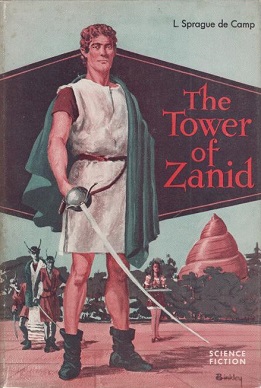
The Tower of Zanid is a science fiction novel by American writer L. Sprague de Camp, the sixth book of his Viagens Interplanetarias series and the fourth of its subseries of stories set on the fictional planet Krishna. Chronologically it is the seventh Krishna novel. It was first published in the magazine Science Fiction Stories for May 1958. It was first published in book form in hardcover by Avalon Books, also in 1958, and in paperback by Airmont Books in 1963. It has been reissued a number of times since by various publishers. For the later standard edition of Krishna novels it was published together with The Virgin of Zesh in the paperback collection The Virgin of Zesh & The Tower of Zanid by Ace Books in 1983. An E-book edition was published by Gollancz's SF Gateway imprint on September 29, 2011 as part of a general release of de Camp's works in electronic form. The novel has also been translated into Italian and German.

The Continent Makers is a science fiction novella by American writers L. Sprague de Camp, part of his Viagens Interplanetarias series. It was first published in the magazine Thrilling Wonder Stories in the issue for April, 1951. It first appeared in book form in the collection The Continent Makers and Other Tales of the Viagens, published in hardcover by Twayne Publishers in 1953, and in paperback by Signet Books in 1971. It has also been translated into Portuguese, Dutch, and Italian.
Bibliography of science fiction, fantasy, historical fiction and nonfiction writer L. Sprague de Camp:
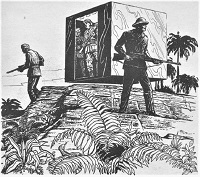
"A Gun for Dinosaur" is a time travel science fiction story by American writer L. Sprague de Camp as part of his Rivers of Time series. It tells the story of four men who travel into the past to hunt dinosaurs.
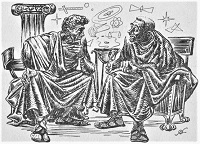
"Aristotle and the Gun" is a time travel and alternate history science fiction story by American writer L. Sprague de Camp.

"The Galton Whistle" is a science fiction short story by American writer L. Sprague de Camp, a story in his Viagens Interplanetarias series. It is the first (chronologically) set on the planet Vishnu. It was first published, as "Ultrasonic God," in the magazine Future Combined with Science Fiction Stories in the issue for July, 1951. It first appeared in book form under the present title in the collection The Continent Makers and Other Tales of the Viagens, published in hardcover by Twayne Publishers in 1953, and in paperback by Signet Books in 1971. It also appeared in the anthologies Novelets of Science Fiction, The Good Old Stuff, and The Good Stuff. The story has been translated into Portuguese, Dutch, and Italian.

"Judgment Day" is an apocalyptic science fiction story by American writer L. Sprague de Camp. It was first published in the magazine Astounding Science Fiction for August, 1955, and first appeared in book form in the anthology The Best Science Fiction Stories and Novels: 1956. It later appeared in the de Camp collections A Gun for Dinosaur and Other Imaginative Tales, and The Best of L. Sprague de Camp ,), as well as the anthologies Great Science-Fiction, A Science Fiction Argosy, and Masters of Darkness III. The story has also been translated into German.
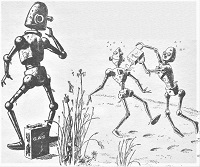
"Internal Combustion" is a classic science fiction robot story by L. Sprague de Camp. It was first published in the magazine Infinity Science Fiction for February, 1956. It first appeared in book form in the collection A Gun for Dinosaur and Other Imaginative Tales ; it later appeared in the anthologies Souls in Metal and Top Science Fiction: The Authors' Choice. The story has been translated into German.

"The Guided Man" is a classic science fiction short story by L. Sprague de Camp. It was first published in the magazine Startling Stories for October, 1952. It first appeared in book form in the collection A Gun for Dinosaur and Other Imaginative Tales. It has also appeared in Science Fiction Yearbook no. 3 and the collection The Best of L. Sprague de Camp. The story has been translated into German.

Rare Science Fiction is an anthology of science fiction short stories edited by Ivan Howard. It was first published in paperback by Belmont Books in January 1963. The collection has been translated into Portuguese.
"The Egg" is a science fiction short story by L. Sprague de Camp. It was first published in the magazine Satellite Science Fiction for October, 1956. It first appeared in book form in the collection A Gun for Dinosaur and Other Imaginative Tales. The story has been translated into German.
"Let's Have Fun" is a science fiction short story by L. Sprague de Camp. It was first published in the magazine Science Fiction Quarterly for May, 1957. It first appeared in book form in the collection A Gun for Dinosaur and Other Imaginative Tales, and afterwards appeared in the anthology Rare Science Fiction. The story has been translated into German.
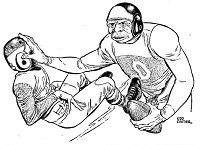
"Throwback" is a classic science fiction short story featuring atavism by L. Sprague de Camp. It was first published in the magazine Astounding Science Fiction for March, 1949. It first appeared in book form in the collection A Gun for Dinosaur and Other Imaginative Tales ; it later appeared in the anthology Apeman, Spaceman. The story has been translated into Italian and German.




